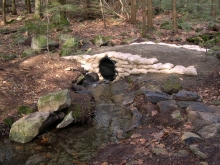You are here
New Study: Small Streams Transport Key Forest Nutrients

Headwater streams--small tributaries in the outer reaches of a watershed--are the smallest parts of river networks. But collectively, they make up more than half the miles of flowing water in the U.S. According to a new Harvard Forest study in the journal Ecosystems, headwater streams tell us volumes about the impacts of seasonal storms on forest ecosystems and water quality.
Today at Harvard Forest, there are nearly twice as many seasonal storms each year than there were a century ago. During storms and snowmelt, stored carbon and forest nutrients like nitrogen leach out of the soil and into streams. The new study explains where the carbon and nitrogen go next--some released to the air as carbon dioxide (a greenhouse gas), some pulsed downstream as food for organisms, some causing both good and bad outcomes for water quality.
The study required several years of intense biogeochemical and hydrological data collection in Bigelow Brook by Harvard Forest collaborators William Sobczak from the College of the Holy Cross, and James Saiers, Peter Raymond, and Henry Wilson from the Yale School of Forestry and Environmental Studies. The work was supported by the Harvard Forest Long-Term Ecological Research Program, the Yale Institute for Biospheric Studies, and the National Science Foundation.

